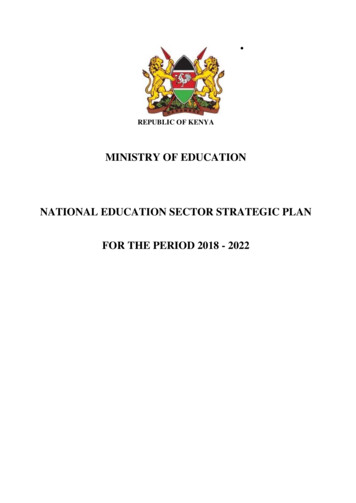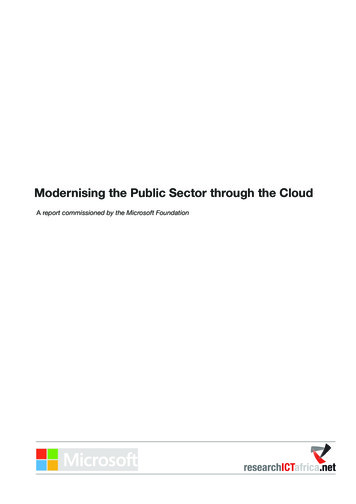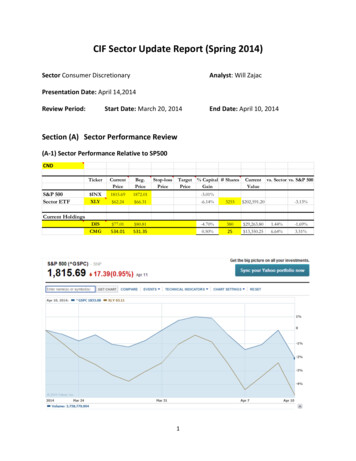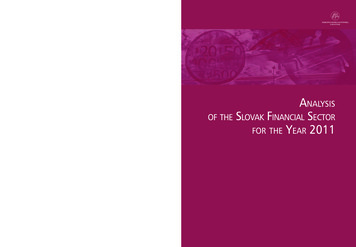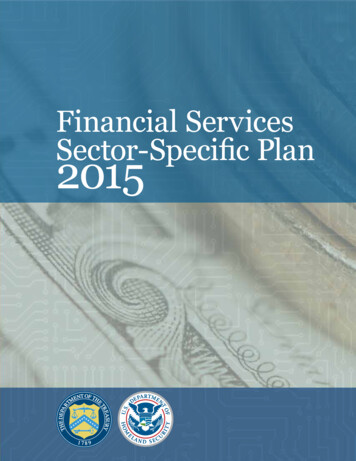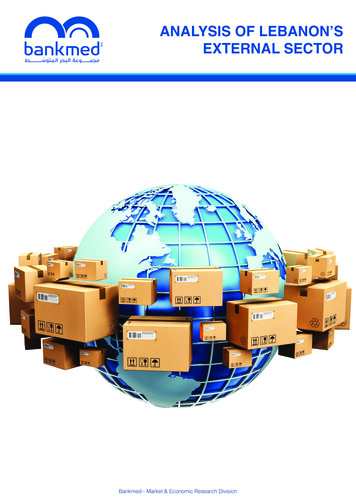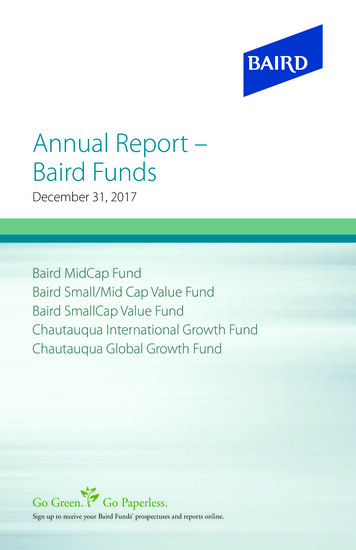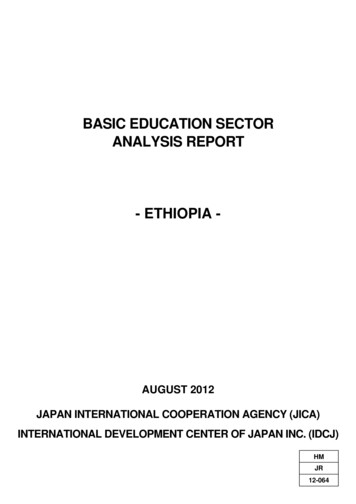
Transcription
BASIC EDUCATION SECTORANALYSIS REPORT- ETHIOPIA -AUGUST 2012JAPAN INTERNATIONAL COOPERATION AGENCY (JICA)INTERNATIONAL DEVELOPMENT CENTER OF JAPAN INC. (IDCJ)HMJR12-064
BASIC EDUCATION SECTORANALYSIS REPORT- ETHIOPIA -AUGUST 2012JAPAN INTERNATIONAL COOPERATION AGENCY (JICA)INTERNATIONAL DEVELOPMENT CENTER OF JAPAN INC. (IDCJ)
(Source: UN Emergency Unit for Ethiopia, March 2000)Map of Ethiopia
ative Basic EducationAlternative Basic Education CenterAfrican Development BankAnnual Review MeetingGerman Federal Ministry for Economic Cooperation and Development/ GermanAgency for International CooperationBureau of Finance and Economic y Assistance StrategyCatalytic FundCanadian International Development AgencyContinuous Professional DevelopmentCluster Resource CenterCollege of Teacher EducationDepartment for International DevelopmentEthiopian CalendarEuropean CommissionEarly Childhood Care and EducationEducation for AllEarly Grade Reading AssessmentEthiopian Higher Education Entrance Certificate ExaminationEnglish Language Improvement CenterEnglish Language Quality Improvement ProgramEnglish Language Training Improvement ProgramEducation Management Information SystemEPF:EPRDF:ESDP:Education Pooled FundEthiopian People's Revolutionary Democratic FrontEducation Sector Development ProgramEGSECE:ETB:ETP:FAL:FTI:GDP:GEQIP:GER:GNI (PPP):GTP:Ethiopian General Secondary Education Certificate ExaminationEthiopian BirrEducation and Training PolicyFunctional Adult LiteracyFast Track InitiativeGross Domestic ProductGeneral Education Quality Improvement ProgramGross Enrollment RateGross National Income (Purchasing Power Parity)Growth and Transformation PlanCapacity Development Results Frameworki
HDP:HIV/AIDS:ICT:Higher Diploma ProgramHuman Immunodeficiency Virus/Acquired Immune Deficiency SyndromeInformation Communication nal Development AssociationInternational Development Center of Japan Inc.In-service Education and TrainingInternational Standard Classification of Education (of the UNESCO)Japan International Cooperation AgencyJoint Review an Development BankMillennium Development GoalsMulti Donor Trust FundMinimum Learning CompetencyMinistry of EducationMinistry of Finance and Economic DevelopmentNational Adult Education StrategyNon Governmental OrganizationNet Intake RateNational Learning AssessmentOromia Education BureauPlan for Accelerated and Sustained Development to End PovertyProtection of Basic Services ProgramPublic Expenditure ReviewProgramme for International Student AssessmentProgram Preparation FundPre-service Education and TrainingPrimary School Leaving Certificate ExaminationPupil Section RatioParent Teacher AssociationPupil Teacher RatioRegional Education BureauThe Southern and Eastern Africa Consortium for Monitoring Educational QualitySchool Based English MentoringSwedish International Development Cooperation AgencySchool Improvement Plan/ ProgrammeThe Project on Increasing Access to Quality Basic Education throughDeveloping School Mapping and Strengthening Micro-PlanningStrengthening of Mathematics and Science EducationSchool Management Information SystemSNNP:Southern Nations, Nationalities and People’s Regionii
STI:SWS:TDP:Science, Technology and InnovationSector Working GroupTeacher Development ProgrammeTEACH:TELL:TESO:ToT:TTI:TVET:Transforming Education for Adults and Children in the HinterlandTeach English for Life LearningTeacher Education System OverhaulTraining of TrainersTeacher Training InstituteTechnical and Vocational Education and O:WOFED:WS:ZEO:United Nations Educational, Scientific and Cultural OrganisationUNESCO Institute for StatisticsUnited Nations International Children's Emergency FundUniversal Primary EducationUnited States Agency for International DevelopmentUnited States DollarWoreda Education OfficeWorld Food ProgrammeWorld Health OrganisationWoreda Office of Finance and Economic DevelopmentWork ShopZone Education Officeiii
iv
Executive SummaryChapter 1: Outline of the StudyAs the target year of the Millennium Development Goals (MDGs) and Education for All (EFA)approaches, non-traditional forms of aid modalities such as SWAPs and general budget supportare progressively tested and used in providing aid. In this context, the Japan InternationalCooperation Agency (JICA) has commissioned a study to carry out a comprehensive andin-depth analysis of the education sector in 13 countries in Sub-Saharan Africa and LatinAmerica 1 so that more strategic and effective programs/projects can be formulated. Thepurpose of the study is twofold: 1) to gather relevant data and information, analyze them, and toidentify priorities in the education sector in each country, and 2) to propose how to improve thequality and the methodologies of JICA’s analysis on basic education.Chapter 2: Political and Socio-economic Situation in EthiopiaIn Ethiopia, a pro-Soviet military junta (the Derg) established a socialist state in 1974. But as aresult of continuing confusion in social conditions, the Ethiopian People’s RevolutionaryDemocratic Front (EPRDF) took over the political power in 1991. The EPRDF government alsowon the election in May 2010, and Prime Minister Meles Zenawi was reappointed. The majoreconomic indicators are: GDP per capita USD 1,040 (PPP, current international ) (2010), GDPgrowth rate 10.1% (2010), life expectancy 58.7 (2010) and adult literacy rate 29.8% (2005).Chapter 3: Educational Policies and ReformsThe basis of the Ethiopian education sector reform is the Education and Training Policy (ETP),enacted in 1994. The Education Sector Development Programme (ESDP) was plannedafterwards to realize ETP and it was the outset of a series of the ESDPs which has continued tobe updated for the subsequent 20 years.In the Growth and Transformation Plan (GTP), a national development plan for 5 years from2010/11 to 2014/15, the government aims to achieve MDGs by 2015 and to become amiddle-income country by 2020-2023. The ESDP-IV (2010/11-2014/15) is the developmentprogramme to realize the GTP and focus on the quality of education, especially implementingthe General Education Quality Improvement Programme (GEQIP) components started in 2008.Supervisory authority is the Ministry of Education, which formulates national plan, frameworksand guidelines. Regarding programme planning, implementation and monitoring, however, it isdelegated to 9 regions and 2 city councils.Chapter 4: Status and Challenges of Basic Education Sector Development[Access] As a result of the policy priority and financial input to achieve universal primaryeducation by 2015 targeted in the ESDPs, primary education achieved a drastic expansion. In1The target countries are Kenya, Ethiopia, Uganda, Rwanda, Malawi, Zambia, Cameroon, Senegal, Mali,Niger, Burkina Faso, Guatemala, and Nicaragua.i
2010/11, the gross enrollment rate (GER) was 96.4% in primary education. The net enrollmentrate (NER) marked 85.3% in 2010/11, the highest ever and showing a significant improvementfrom 52.2% in 2001/02. Now, the wave of increasing enrollment has reached secondaryeducation, improving GER of general secondary schools for the last 10 years to as high as38.4% in 2010/11. The GER of the entire secondary education was 16.3% in 2010/11, slightlydecreased from the previous year.[Internal Efficiency] When assuming the enrollment of 2002 was 1000, the cohort survival rateof grade 5 was 550 and the students who graduated in 8 years were only 264, meaning that onlyone fourth of the entrants survived. The grades which have many repeaters and readmits aregrades 1, 2 and 8. Repetition rate of primary education is 13.1% (2010/11), and the highest wasrecorded in grade 8 (12.3%). Comparing with other African countries, promotion and cohortsurvival rates in Ethiopia are lower than other countries. The average duration of study forgraduates was 8.3 to 8.9 years in the past ten years. In most cases, the duration of girls is longerthan that of boys.[Equity] Girls have relatively lower GER and completion rate than boys in the first cycle ofprimary education (grades 1 to 4). Even for the repetition rate, girls are higher than boys inrecent years. Although the national average of GPI is 0.94 and getting closer to 1, some regionsstill have lower Gender Parity Index (GPI) than other regions, such as 0.78 and 0.88. Looking atregional figures, Afar and Somali regions, called the Emerging area, have lower indicators thanothers. Besides, looking at urban and rural differences, the access to secondary education inrural area is very limited whereas most (85-95%) of enrollment of secondary education are fromurban area.[Learning Outcomes] The completion rate of primary education has shifted at around 50% inthe last 5 years (52.5% in 2011). The completion rates of girls were lower than those of boys inall the recent years. Regarding the National Learning Assessment (NLA) which is conductedevery four years to grades 4 and 8 students, the total score of grade 4 was 40.1% (2010) and thatof grade 8 was 35.3% (2010), not achieving the minimum learning achievement (50%) that thegovernment targets in the ETP. In addition, the report of the Early Grade Reading Assessmentimplemented by the United States Agency for International Development (USAID) in 2010reported that more than 25% of grade 2 students could not read one word in most regions. Thus,low basic learning ability is critical in Ethiopia.[Learning Environment] Pupil section ratio (PSR) was 57 for the national average and thehighest was recorded in the Somali region at 81 (both in 2010/11). Both fall below the nationalstandard (50 for grades 1 to 4 and 40 for grades 5 to 8). The percentages of schools thatimplement multiple shift are 21.5% in primary education and 32.4% in secondary education.[Textbook Distribution System] In Ethiopia, the federal government develops curriculum andminimum standard and the Regional Education Bureau (REB) adds the local contexts andtranslates it into their local languages. In the textbook development and distribution componentof GEQIP, overseas publishers were selected through the bidding process and the governmentii
approved, evaluated and adopted the textbooks. Regarding the distribution, there are manyschools which have not achieved 1:1, as targeted by the MOE.[Curriculum] Generally, the curriculum is revised every 5 years. The current (new) curriculumframework was issued by the MOE in December 2010. The focus of the reform was a shift fromobjective-based to competency-based curriculum. On the other hand, an issue like the low levelof teachers’ understanding of the new curriculum is pointed out. Also, it is expected that thenational examination system would still assess only cognitive skills even when the nationalcurriculum moves to the competency-based one. It is a challenge to align the nationalexaminations with the curriculum.[Teaching Staff] The number of teachers in Ethiopia has increased 2.5 times in primary schoolsand 3.8 times in secondary schools from 2000/01 to 2010/11. Pupil-teacher ratio (PTR) ofprimary education was 51 (2010/11) and has not achieved the national standard (50), whereasPTR of secondary education was 31 (2010/11) and falls below the standard (40). The issuespointed out are: teachers do not understand basic subject matters; instructors teach wrongknowledge in the colleges and ignore students. Currently, in GEQIP, pre-service trainingprograms for development of teacher training curriculum and module, improvement of teachingpracticum, and capacity building for the College of Teacher Education trainers are implemented.In the in-service training of GEQIP, Continuous Professional Development and EnglishLanguage Quality Improvement Program for all teachers, Project for StrengtheningMathematics and Science Education in Secondary Schools in Ethiopia (SMASE) tostrengthening capacity of mathematics and science teachers, and the upgrading system areimplemented. Regarding the teacher’s salary standard, it remains relatively low when comparedto other nations. Frameworks of management of teachers are articulated by the federalgovernment, recruitment, promotion and transfer standards are defined by regions, anddeployment, salary payment, transfer and promotion are handled by woredas.Chapter 5: Public Finance and Administration in the Education SectorDecentralization has been taking place in Ethiopia. Implementation and management of primaryeducation and (in most cases) junior secondary education are managed by Woreda EducationOffice (WEO). Regions manage senior secondary education, Technical and VocationalEducation and Training (TVET) and the institutions training teachers for primary and juniorsecondary education.The management capacity of the MOE can be evaluated well in terms of participatory planningand accountability in involvement of various stakeholders in the ESDP planning process.Nevertheless, the commitment of the MOE is not yet enough considering that some officialscomment that “since implementation is done in regions, we do not know about it” and that MOEhas not calculated the projected number of teachers in the mid-term period. The efficiency ofmanagement capacity can be also rated relatively low since official documents that regulateauthority of the WEO and Zone Education Office do not exist and there is no clear measurementon woreda’s capacity development and comprehensive monitoring. Furthermore, a concern oniii
decreased budget allocation to the education sector in each region, deterioration of students’learning achievement, and unachieved indicators at the end of ESDP-III also show issues interms of effectiveness. Therefore, utilizing the analytical framework of the CapacityDevelopment Results Framework of the World Bank Institute, the relevance, efficiency andeffectiveness of the management of the MOE may be concluded relatively low.In the public education finance, the proportion of the federal government is almost 50%,whereas the share of the region governments are approximately 25% and that of the woredagovernments are approximately 25%. Considering the fact that 92% of the woreda budget isallocated to teacher salary, the budget disbursed to schools is very little and falls far behind thegovernment’s target at 20% (non-salary recurrent expenditure).There are two kinds of block grants in Ethiopia: the government’s Block Grant and GEQIPSchool Grant. The former capitation amount is fixed by the government, but in reality, theamounts and way of distribution are different in each region. The latter capitation amount is alsofixed in the School Improvement Plan of GEQIP, and distributed directly to schools. Assumingthat the school-age population of Ethiopia increases by 10% and that per-pupil inputs are raisedto achieve the national standard PSR and PTR, the national projection of teachers in 2015/16 is440,000, requiring ETB 18.8 billion in the educational budget(2015/16).Chapter 6: Trends in Donor AssistanceThe donor cooperation in the education sector in Ethiopia is divided into two types: financialsupport donors (UK, the Netherlands, Sweden and Finland) and technical assistance donors(USAID, UNICEF, UNESCO and JICA). But there is no trend drastically shifting the aid tofinancial support. The relatively big contributors are the World Bank, EC, UNICEF, DFID andUSAID. Currently, GEQIP is the main pool-fund program among the three pool-fund programs:(1) GEQIP, (2) Education pool-fund, and (3) PBS (Protection of Basic Services Program).Chapter 7: Results of AnalysisWhen comparing education indices and benchmark indices of the FTI indicative framework ofother countries in Sub-Saharan Africa, those of Ethiopia are moderate. The proportion of theeducation sector in the government expenditure was the highest in the 11 countries. On the otherhand, the dropout rate in primary education and PTR were relatively low level, and indicatesthat there are issues in the quality of education and internal efficiency. Factor analysis of theseproblems is as follows.Firstly, in terms of equity, there are big differences between regions like the Somali, Afar andGambera and other regions, between urban and rural areas, and between male and femalestudents. Although the government has formulated and implemented various education policiesto improve the disparities, the outcome has not been seen yet. Reasons can be: (i) there aremany poor households in the areas and parents cannot afford school expenses, (ii) some familiesprefer early marriage and are reluctant to educate girls, (iii) PTR is high, (iv) there is an issue ofdeployment of qualified teachers, (v) policies of the MOE cannot be implemented as it wasiv
planned in the woreda level, and (vi) achievement level of girls and rural pupils in the certificateexamination is lower than boys.Secondly, access to secondary education is another issue. In the primary school leavingcertificate examination, the passing criteria and the number of non-passing students are decidedby the capacity of secondary education, which limits universal access to secondary education.Actually, the number of secondary school is very few especially in rural area. The language ofinstruction being English from secondary education is also another obstacle. Moreover, girlstend to resist going to secondary boarding schools from grade 9 which maintains the lowtransition rate.Thirdly, low internal efficiency is critical. The problems in the grade 1 can be analyzed thatclassrooms are overclouded thus teachers cannot take care of all children. The reason behind thehigh repetition/dropout rates of grade 5 can be interpreted that the quality of education isdeteriorated with classroom congestion when students transfer from satellite schools to remotecluster schools when entering the second cycle of primary education. On the other hand, thebackground of the low internal efficiency in grades 7 and 8 is considered that parents try toavoid their children’s taking examinations due to the lack of confidence to achieve a high markin examinations.Fourthly, it is thought that the quality of education was deteriorated because Ethiopia tried toachieve universal primary education. It caused the lack of textbooks, teaching materials, teachertraining, administrative evaluation and monitoring and eventually discouraged creation of aneffective learning environment. The lack of reading ability caused by the lack of readingmaterials, the lack of learning hours, and the lack of learning and understanding caused byadoption of shift-classes could be also factors. Moreover, the problems are also pointed out inteachers: some teachers do not conduct assessment of students properly, they have lowmotivations, they cannot get away from conventional way of teaching, and teachers themselvesdo not know how to pronounce and teach correctly their own language.Fifthly, although the proportion of the education sector in Ethiopia is relatively high, sharing 5%of GDP and 21.1% of the government public expenditure (2007/08), educational internalefficiency is low. Possible reasons include low level of financial distribution to woredas and ahigh share of teacher salary which may leave little budget left for schools. Besides, althoughmuch of the recurrent budget is spent for teachers, the quality of lessons has not been improvedyet, and thus has not contributed to students’ learning outcome.In the ESDP-IV, to improve access and quality are raised as priorities. However, many of therelated policies are on institutional and quantitative measures that lack in approach to improvingteachers’ quality, mindset and pedagogy. Even for the curriculum development, there is noconcrete policy on how to connect the new curriculum to pre-service training, in-service training,examination system and classroom evaluation system and practice. In order to improve thequality of education through GEQIP, it would be necessary to have further discussion andfacilitation on ‘what is academic ability?,’ ‘what is learning achievement?,’ and ‘what is a goodv
lesson?’Through this study, the following challenges and considerations are identified: (1) too manyitems to research and limited information on REB except Oromia region, and (2) unbalancedinformation on research items.vi
BASIC EDUCATION SECTOR ANALYSIS REPORT- ETHIPIA–Table of ContentsMapAbbreviationsExecutive SummaryCHAPTER 1: OUTLINE OF THE STUDY. 11.1BACKGROUND . 11.2OBJECTIVES OF THE STUDY . 11.3BASIC APPROACHES OF THE STUDY . 11.4TARGET AREAS/COUNTRIES . 21.5MAJOR STEPS AND SCHEDULE . 21.6STUDY TEAM. 3CHAPTER 2: POLITICAL AND SOCIO-ECONOMIC SITUATION IN ETHIOPIA . 42.1POLITICAL SITUATION . 42.2SOCIO-ECONOMIC SITUATION . 4CHAPTER 3: EDUCATIONAL POLICIES AND REFORMS . 63.1NATIONAL DEVELOPMENT PLAN . 63.2EDUCATION LAW . 63.3EDUCATION POLICY . 73.3.1Education and Training Policy (ETP) . 73.3.2Science, Technology and Innovation Policy (STI). 73.4EDUCATION SYSTEM . 83.5EDUCATION SECTOR DEVELOPMENT PROGRAM (ESDP) . 83.6SUPERVISORY AUTHORITY . 9CHAPTER 4: STATUS AND CHALLENGES OF BASIC EDUCATION SECTORDEVELOPMENT. 104.1ACCESS . 104.1.1School Age Population . 104.1.2Enrollment Trends . 104.1.3Enrollment Trend of Primary Education . 134.1.4Enrollment Trend of Secondary Education . 144.1.5Literacy Education . 154.2INTERNAL EFFICIENCY (QUANTITATIVE INTERNAL EFFICIENCY) . 154.3EQUITY . 184.3.1Comparative Analysis of Access by Group . 184.3.2Education for Children with Special Needs and Inclusive Education . 224.4QUALITY OF EDUCATION . 23
4.4.1Situation of Learning Outcome . 234.4.2Learning Environment . 254.4.3Procurement and Distribution of Textbooks . 274.4.4Definition of Academic Ability . 284.4.5Quality Assurance System of Education . 284.4.6Curriculum . 314.4.7Languages of Instruction . 334.5TEACHERS . 334.5.1Number of Teachers . 334.5.2Teacher Qualification and Placement. 344.5.3Teacher Education System . 364.5.4Working Conditions for Teachers . 394.5.5Teacher Recruitment / Management . 39CHAPTER 5: PUBLIC FINANCE AND ADMINISTRATION IN THE EDUCATION SECTOR . 415.1PUBLIC ADMINISTRATION . 415.1.1Decentralization in the Education sector . 415.1.2Management Capacity of the Ministry of Education . 435.2EDUCATIONAL FINANCE . 465.2.1Budget of Education Sector . 465.2.2Flow and Administration of Funds Provided by Donors . 495.2.3Private Education Expenditure . 505.2.4Unit Cost Analysis . 515.2.5Projection of Midterm Demand and Cost for Teachers . 515.2.6Management System of Education Budget / Public Expenditure . 535.2.7Distribution of Grants . 54CHAPTER 6: TRENDS IN DONORS ASSISTANCE . 566.1STRUCTURE OF DONOR COORDINATION . 566.2TRENDS OF COOPERATION BY EACH DONOR . 56CHAPTER 7:RESULTS OF ANALYSIS. 607.1TOP PRIORITIES IN THE BASIC EDUCATION SECTOR . 607.2FACTOR ANALYSIS OF TOP PRIORITIES . 627.3PRIORITIES OF KENYA’S EDUCATION POLICY . 647.4CHALLENGES AND NECESSARY CONSIDERATIONS . 65Annex:Annex ISurvey Items and IndicatorsAnnex IIItinerary of the Field SurveyAnnex IIICollected DataAnnex IVReferences
CHAPTER 1: OUTLINE OF THE STUDY1.1BackgroundTo attain the goals of Education for All (EFA) and Millennium Development Goals (MDGs) bythe 2015 deadline, the developing countries have been engaged in quantitative and qualitativeimprovement in basic education in collaboration with the cooperating partners (CPs). For somedeveloping countries, reaching all of these goals by the target year still remains challenging. Inthe area of basic education improvement, sector-wide approaches (SWAps) have been moreemphasized through direct budget support rather than through project-type interventions. Therehave been growing concerns in the limited capacity of the developing countries in planning,budgeting, implementation, and monitoring and evaluation, which might negatively affect aideffectiveness and transparency.Japan International Cooperation Agency (JICA) has provided various project-type and/orprogram-type interventions, including technical assistance, classroom construction, educationequipment procurement etc., in line with the education sector program of the developingcountries. In order to implement more str
education, improving GER of general secondary schools for the last 10 years to as high as 38.4% in 2010/11. The GER of the entire secondary education was 16.3% in 2010/11, slightly decreased from the previous year. [Internal Efficiency] When assuming the enrollment of 2002 was 1000, the cohort survival rate
